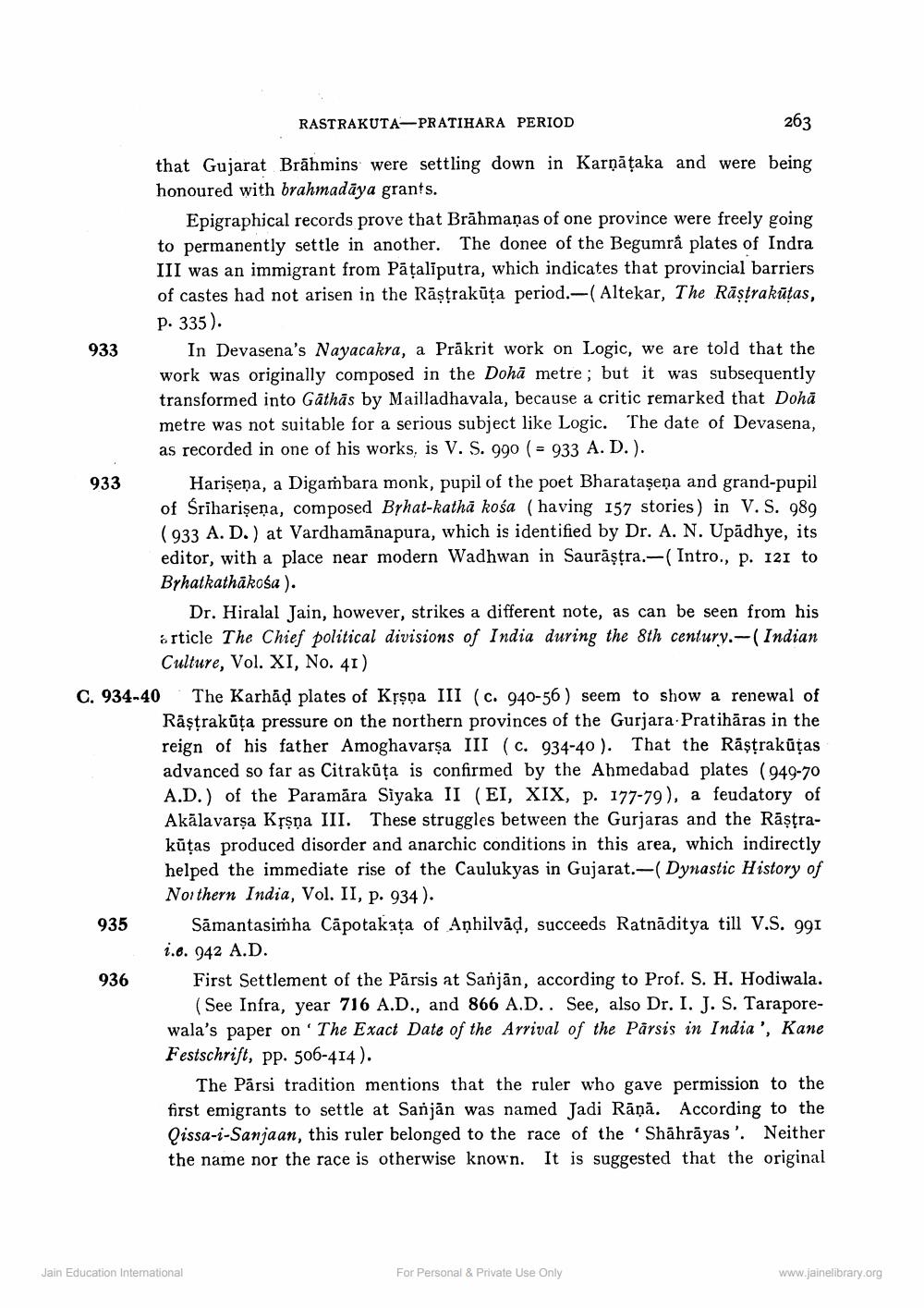________________
RASTRAKUTA-PRATIHARA PERIOD
263
that Gujarat Brāhmins were settling down in Karņāțaka and were being honoured with brahmadāya grants.
Epigraphical records prove that Brāhmaṇas of one province were freely going to permanently settle in another. The donee of the Begumră plates of Indra III was an immigrant from Pāšalīputra, which indicates that provincial barriers of castes had not arisen in the Rāştrakūța period.-(Altekar, The Rāştrakūtas,
P. 335). 933 In Devasena's Nayacakra, a Prakrit work on Logic, we are told that the
work was originally composed in the Dohā metre; but it was subsequently transformed into Gathās by Mailladhavala, because a critic remarked that Dohā metre was not suitable for a serious subject like Logic. The date of Devasena,
as recorded in one of his works, is V. S. 990 ( = 933 A. D.). 933 Harişeņa, a Digambara monk, pupil of the poet Bharataşeņa and grand-pupil
of Sriharişena, composed Byhat-kathā kośa (having 157 stories) in V. S. 989 ( 933 A. D.) at Vardhamānapura, which is identified by Dr. A. N. Upadhye, its editor, with a place near modern Wadhwan in Saurāşțra.-( Intro., p. 121 to Byhatkathākośa).
Dr. Hiralal Jain, however, strikes a different note, as can be seen from his érticle The Chief political divisions of India during the 8th century.-(Indian
Culture, Vol. XI, No. 41) C. 934-40 The Karhāļ plates of Krşņa III (c. 940-56 ) seem to show a renewal of
Rāşțrakūța pressure on the northern provinces of the Gurjara. Pratihāras in the reign of his father Amoghavarşa III (C. 934-40). That the Rāştrakūtas advanced so far as Citrakūta is confirmed by the Ahmedabad plates (949-70 A.D.) of the Paramāra Siyaka II (EI, XIX, p. 177-79), a feudatory of Akālavarşa Kļşņa III. These struggles between the Gurjaras and the Rāstrakūļas produced disorder and anarchic conditions in this area, which indirectly helped the immediate rise of the Caulukyas in Gujarat.-( Dynastic History of
Northern India, Vol. II, p. 934). 935 Samantasimha Capotakata of Aņbilvād, succeeds Ratnāditya till V.S. 991
1.8. 942 A.D.
First Settlement of the Pārsis at Sanjān, according to Prof. S. H. Hodiwala.
(See Infra, year 716 A.D., and 866 A.D.. See, also Dr. I. J. S. Taraporewala's paper on 'The Exact Date of the Arrival of the Parsis in India', Kane Festschrift, pp. 506-414).
The Pārsi tradition mentions that the ruler who gave permission to the first emigrants to settle at Sanjān was named Jadi Rāņā. According to the Qissa-;-Sanjaan, this ruler belonged to the race of the Shāhrāyas'. Neither the name nor the race is otherwise known. It is suggested that the original
936
Jain Education International
For Personal & Private Use Only
www.jainelibrary.org




